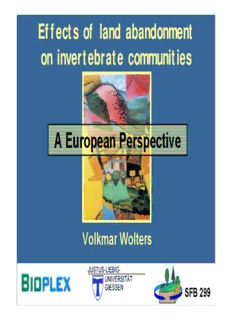
Effects of land abandonment on invertebrate communities A PDF
Preview Effects of land abandonment on invertebrate communities A
Effects of land abandonment on invertebrate communities A European Perspective Volkmar Wolters SFB 299 Europe‘s Landscape is ‚Man-made‘ John Constable Europe‘s Landscape is ‚Man-made‘ D.C. Magnotto TThhee ccuullttuurraall llaannddssccaappeess ooff EEuurrooppee - Human intervention since centuries - Open landscapes with new types of habitats Increase of Biodiversity Europe(cid:146)s Biodiversity is determined by land use NNaattiivvee vvss.. AAnntthhrrooppooggeenniicc HHaabbiittaattss % of forest species in regional pool from: Schaefer (1996) (modified) AAbbaannddoonnmmeenntt && BBiiooddiivveerrssiittyy • Abandonment • Succession • Habitat loss Biodiversity decline Challenge to Conservation: Maintaining the landscape in a state of intermediate disturbance Facing the Challenge A Case Study SFB 299 SSttuuddyy RReeggiioonnss Germany Berlin SLS LDB Southern Lower Saxony Frankfurt • high intensity farming Lahn-Dill-Bergland • marginal region • low intensity farming SFB 299 Comparison of the two regions Species richness of Carabids 400 y 300 SLS t i s n e d y LDB it 200 * v i t c a n Forest a e 100 m 0 carnivorous phytophagous mixophagous PPrroobblleemm Determining the richness of invertebrates is de facto impossible. Solution: focussing on taxa that (i) are functionally important (e.g. Decomposers), (ii) impact habitat quality (‚Ecosystem engineers’), (iii) are biodiversity indicators. SFB 299
Description: